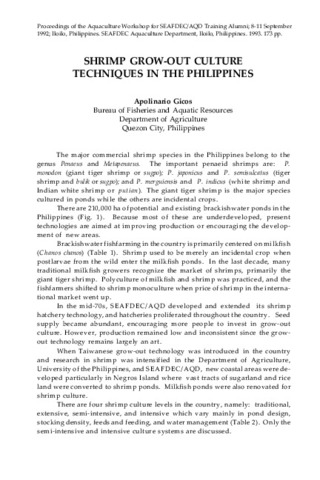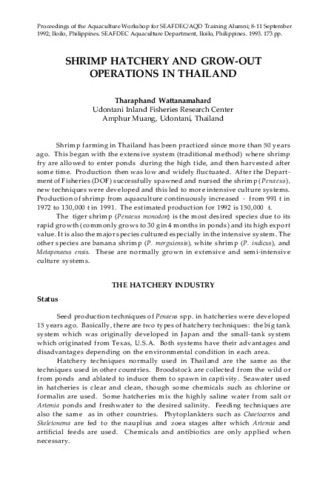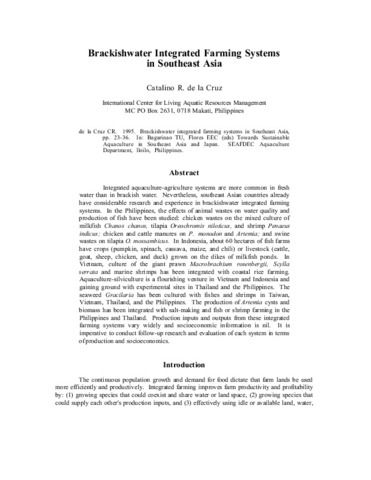Growth, molting, food ingestion, and absorption in juvenile Macrobrachium rosebergii in relation to dissolved oxygen
| dc.contributor.author | Llobrera, Jose A. | |
| dc.contributor.author | Neill, William H. | |
| dc.contributor.editor | De Pauw, Niels | |
| dc.contributor.editor | Jaspers, Edmonde | |
| dc.contributor.editor | Ackefors, Hans | |
| dc.contributor.editor | Wilkins, Noël | |
| dc.date.accessioned | 2011-06-22T09:36:09Z | |
| dc.date.available | 2011-06-22T09:36:09Z | |
| dc.date.issued | 1989 | |
| dc.identifier.citation | Llobrera, J. A., & Neill, W. H. (1989). Growth, molting, food ingestion, and absorption in juvenile Macrobrachium rosebergii in relation to dissolved oxygen. In N. De Pauw, E. Jaspers, H. Ackefors, & N. Wilkins (Eds.), Aquaculture—A Biotechnology in Progress. Proceedings of the International Conference Aquaculture Europe ’87, 2-5 June 1987, Amsterdam, The Netherlands (Vol. 1, pp. 395–400). Bredene, Belgium: European Aquaculture Society. | en |
| dc.identifier.isbn | 9071625036 | |
| dc.identifier.uri | http://hdl.handle.net/10862/516 | |
| dc.description.abstract | Growth, molting, food ingestion, and absorption in juvenile Macrobrachium rosenbergii were evaluated at 2.5, 3.5, 5.0, and 7.7ppm dissolved oxygen (DO), 29°C, and 0.5°/oo salinity. DO levels were maintained by bubbling nitrogen gas against water flowing down through PVC gas-exchange columns. Prawns (0.58 to 0.60g dry weight) were grown individually in 4 l glass chambers for 40 days and fed in excess twice daily. In a separate experiment, food ingestion and absorption in prawns (0.66 to 1.36g dry weight acclimated to the tour DO levels were determined gravimetrically. Growth rate was significantly reduced only at 2.5ppm DO. The mean growth rates, as percentage dry weight increase per day, were 0.76, 1.56, 1.81, and 1.76% at 2.5, 3.5, 5.0, and 7.7ppm DO, respectively. Molting was not inhibited at the tour DO levels tested. Intermolt periods of all prawns ranged trom 8 to 18 days with a mean of 13.6 days. Food ingestion was reduced at 2.5ppm DO, but apparent absorption of dry matter was independent of oxygen at the tour levels tested. Mean ingestion rates, as percentage of dry body weight were 5.51, 8.85, 8.05, and 10.35%. The mean apparent absorption efficiency of all prawns was 87.95%. This study showed that juvenile M. rosenbergii requires about 3.5ppm DO to grow optimally in the laboratory. Reduction in growth of M. rosenbergii at DO levels below 3.5ppm is due in part to a reduction in food intake and not to changes in absorption efficiency and molting frequency. | en |
| dc.language.iso | en | en |
| dc.publisher | European Aquaculture Society | en |
| dc.subject | Crustacea | en |
| dc.subject | Giant freshwater prawn culture | en |
| dc.subject | U.S.A. | en |
| dc.subject | Prawns | en |
| dc.subject | Giant freshwater prawn | en |
| dc.subject.lcc | VF SP 321 | |
| dc.title | Growth, molting, food ingestion, and absorption in juvenile Macrobrachium rosebergii in relation to dissolved oxygen | en |
| dc.type | Conference paper | en |
| dc.citation.spage | 395 | |
| dc.citation.epage | 400 | |
| dc.citation.conferenceTitle | Aquaculture - A Biotechnology in Progress. Proceedings of the International Conference Aquaculture Europe '87, 2-5 June 1987, Amsterdam, The Netherlands | en |
| dc.subject.asfa | growth | en |
| dc.subject.asfa | molting | en |
| dc.subject.asfa | hypoxia | en |
| dc.subject.asfa | ingestion | en |
| dc.subject.asfa | dissolved oxygen | en |
| dc.subject.asfa | juveniles | en |
| dc.subject.scientificName | Macrobrachium rosenbergii | en |
Files in this item
| Files | Size | Format | View |
|---|---|---|---|
|
There are no files associated with this item. |
|||
This item appears in the following Collection(s)
-
Conference Proceedings [298]



